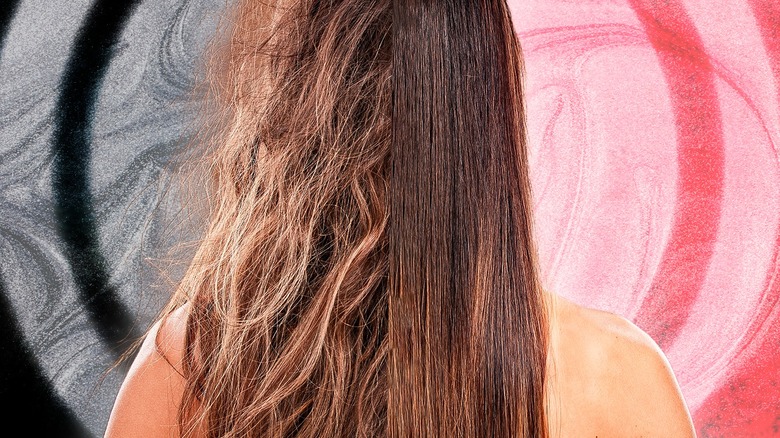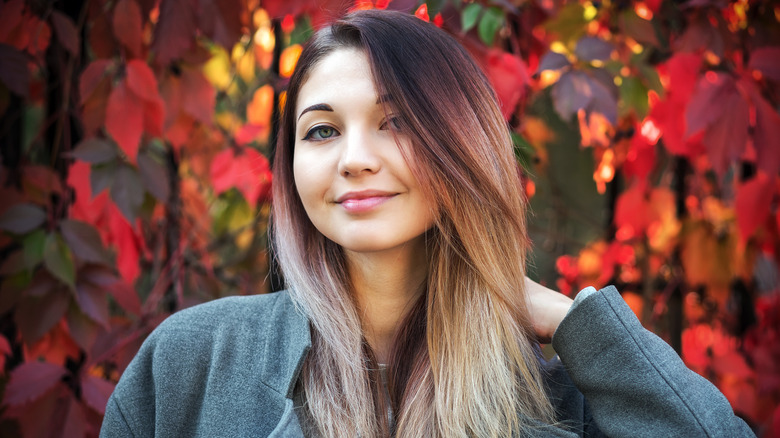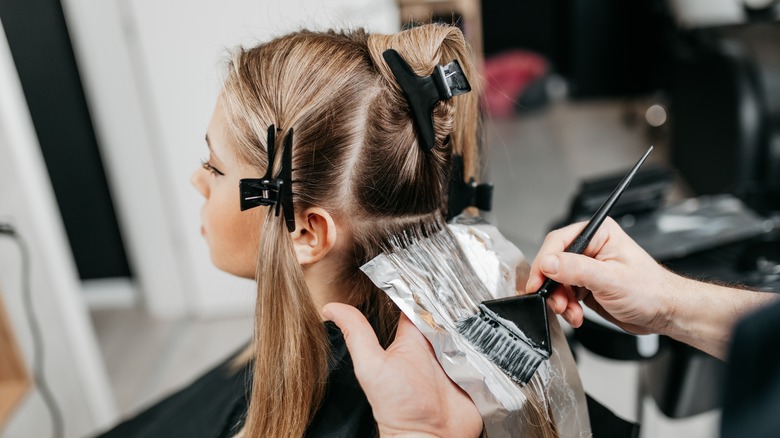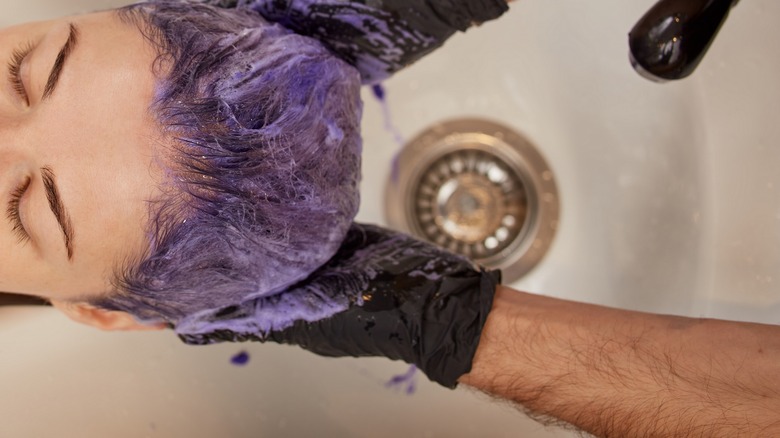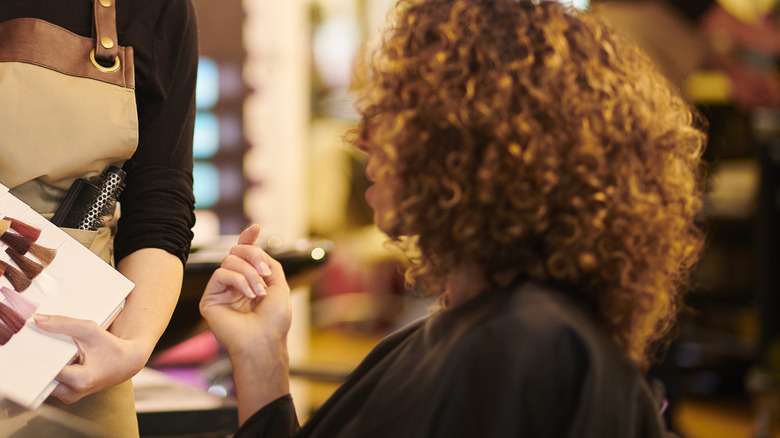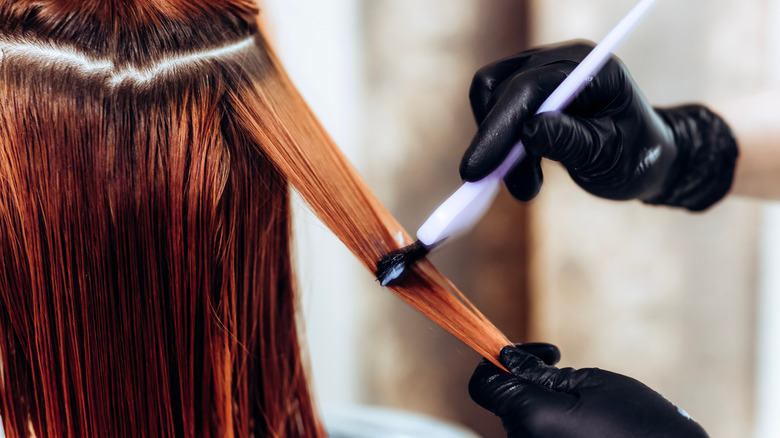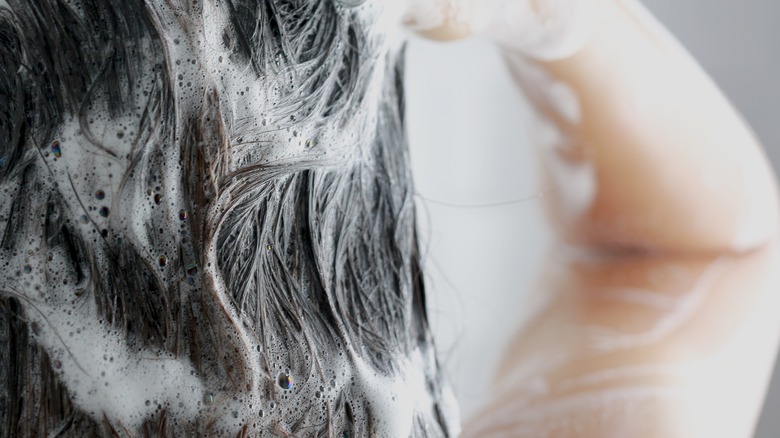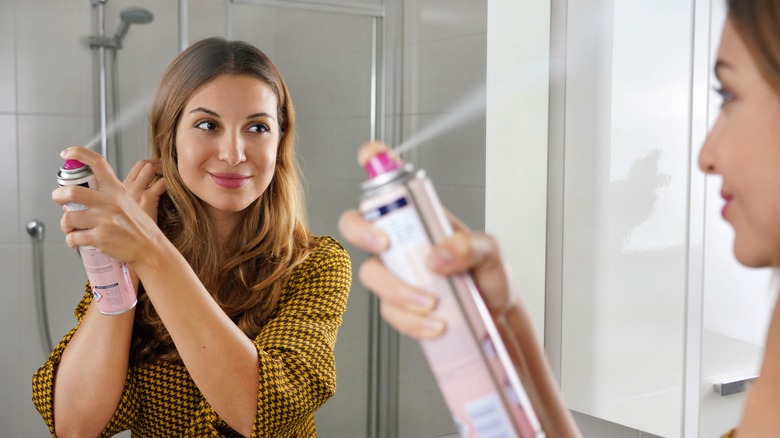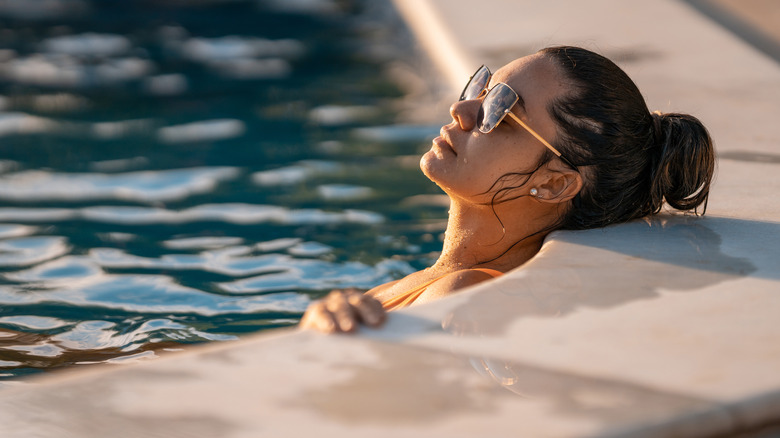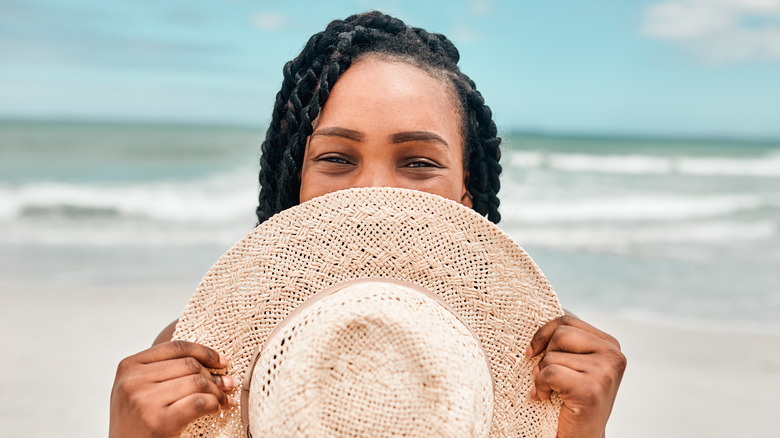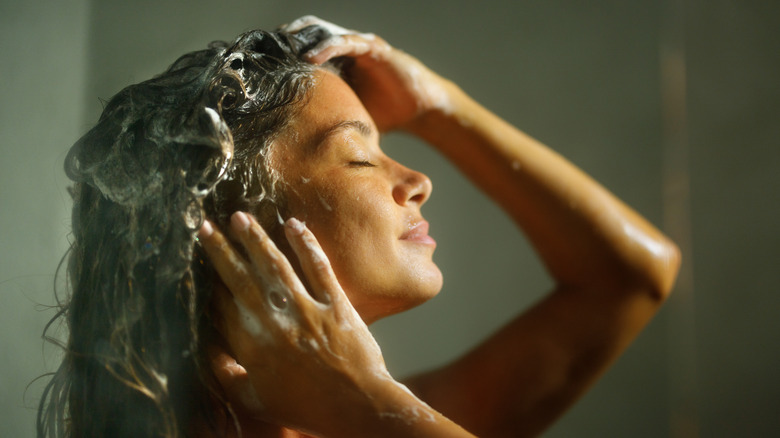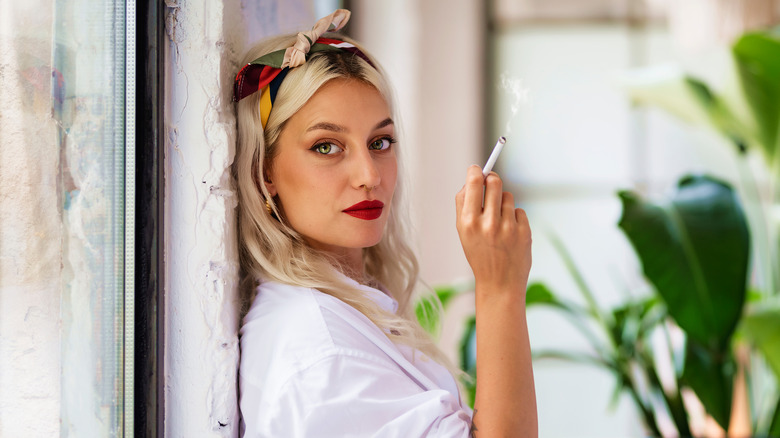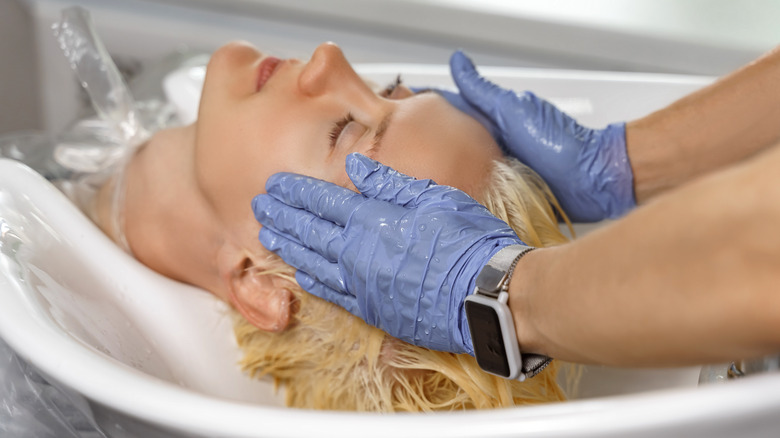The Ultimate Guide To Fixing & Preventing Brassy Hair
Picture this: You recently went to the salon to get your dream hair color and are absolutely loving it. But after a couple of weeks, you begin to notice your color isn't looking quite right. Maybe you're noticing your pretty new platinum blond locks are a little too yellow, or your dark brown balayage is showing signs of red and orange tones you definitely didn't ask for. Chances are, your hair has turned brassy.
Brassiness can occur because of an unprofessional color job, exposure to the elements, or frequent washing and styling. However, it can also be a natural part of the color fading process. Salon owner Anita Green tells The House of Wellness, "Everyone has underlying tones to their hair — the brassiness is actually those undertones creeping in." If you are currently experiencing brassy tresses or want to prevent them from showing up in the first place, don't panic. There are plenty of ways to prevent and correct brassy hair without breaking the bank or sending you back to the salon chair.
What is brassy hair?
Simply put, brassy hair consists of excessive warm undertones. It isn't necessarily a bad thing. In fact, brassy tones can be purposefully added by a stylist to bring buttery or caramel-colored warmth out in certain hair colors. However, many people don't want the brassy undertones that show up in their chosen hair color in the weeks after it's been dyed. "These tones can turn due to sunlight, washing with the wrong shampoo that doesn't protect colored hair, or a mistake made by a colorist, like not using a toner," hairstylist and colorist Jana Rago tells Real Simple. "The sun will dry out the hair by opening the cuticle on the scalp, which will lift the color out, causing the hair to look brassy."
Understanding the science behind hair color and the coloring process is important to combating unwanted brassiness. Almost all hair dyes contain different mixtures of red, blue, and yellow pigments. Cool blue pigments fade more quickly than the warm reds and yellows, even in permanent hair dyes. Once this natural fading concludes, hair color loses its balance of warm and cool tones, and becomes brassy. Black hair often takes on a coppery or reddish hue while dyed blond hair can turn yellow. Environmental factors like smoke and pollutants can also exacerbate fading and contribute to the unwanted tones more quickly if the color isn't applied correctly.
What hair colors are affected by brassiness?
Brassiness can show up in any dyed hair color, but some shades are more prone to it than others. Blond hair is the most likely to turn brassy, especially when people with naturally dark hair decide to go blond. "The darker the hair, the more of a challenge it is to lift the underlying pigment out of the hair, making darker-haired clients more prone to brassy hair," stylist Mirian Lima explains to Stylecaster. "For those who have naturally darker hair, Levels 7 and under, tend to fall into the brassy range." Blonds who go brunette aren't immune to brassiness, however. People with highlights, balayage, or ombré hair can also experience unwanted orange or yellow hues in their hair.
Brassiness affects a variety of hair colors due to the hair lightening process. Dark hair in particular has to be lifted using a mixture of peroxide and ammonia, a combo which dilutes the hair's melanin and exposes the natural warm tones of the hair in an oxidation process. If the lifting is done incorrectly, as sometimes happens if you dye your hair at home, not enough of the natural hair color lightens, which makes it difficult for the artificial hair dye to properly adhere to each strand. As the color fades or washes out quickly, the underlying warm and brassy tones will shine through. The good news is that unwanted brassy hair isn't difficult to fix. It's also easy to prevent no matter what natural color you have or what dyed shade you choose.
Correct brassy hair with color-correcting shampoo
If you've begun to notice your recently dyed locks are taking on an unwanted orange hue, you don't need to run right back to the salon and have your hair recolored. Instead, you can correct the brassiness using color-correcting shampoos and conditioners specially formulated to knock out those brassy tones.
Bottle blonds and people with lighter hair are usually the first to notice their beautiful dye job giving way to dullness, brassiness, or yellow tones. Utilizing a purple-colored shampoo is the key to keeping blond hair looking fresh and well-balanced. "The main reason it is purple is that on the color wheel, it is the opposite color of yellow, which means purple and yellow will cancel one another out," colorist Richy Kandasamy explains to Vogue. "So, when using purple pigment on color-treated brassy or yellow tones, it color-corrects your hair's hue, restoring it to its former natural or neutral brightness with cooler tones." The same concept can be applied to brunettes, whose brassy hues show up in shades of orange or red. Color-correcting blue shampoo and conditioner will neutralize those colors.
Whether you need purple or blue color-correcting shampoo for brassy hair, the application process is the same. Once a week, apply the product evenly to wet hair and let it sit for a couple of minutes. "I usually recommend every third shampoo so that it doesn't dull down the hair," celebrity stylist George Papanikolas tells People. These products can turn your hair murky and muddy if used too often.
Prevent brassiness with an experienced colorist
Brassiness can easily be prevented by going to an experienced colorist for your hair transformations. People who dye their hair at home are often victims of patchy color distribution, flat one-dimensional color, and even serious hair damage due to inexperience. They are also likely to notice brassiness more quickly. Colorist Leanne Chadwick tells Allure, "You have one box dye that 'everyone' can use and achieve the same hair color, therefore, the strength of the developer will need to be strong enough to lift very dark hair, even if someone with really light hair is also using it." This one-size-fits-all approach to haircare doesn't fly at salons, where color is customized to the individual and designed to provide beautiful, natural-looking dimension.
At-home dye jobs also lack the education and experience a professional possesses. Stylists and colorists are familiar with the right products for color-treated hair and the proper techniques to achieve the look you want. Experienced colorists are knowledgeable about the components of hair dye, the science of the lifting and bleaching process, and the proper steps that must be taken in order to achieve a style that stays vibrant for longer.
Ask your stylist for a toner and gloss treatment
In between colorings, you can ask your stylist or colorist for a gloss treatment. "You can correct brassy hair by coming back into your salon and applying a gloss or toner to the hair," celebrity hairstylist Gio Bargallo shares with Good Housekeeping. "This simple fix with a conditioning treatment and blowout make a huge difference."
Like color-correcting shampoos, hair toners help neutralize the unwanted brassiness in dyed hair. Toners come in a range of colors depending on the desired effect, from blue and violet to yellow and green. They can also enhance the color you do want by warming it up or cooling it down, creating a more vivid, vibrant look. Toners can even form a protective barrier around hair and give it some much needed volume.
Alternatively, you can ask your stylist to apply a gloss to your hair. A tinted gloss treatment is less of a commitment than standalone hair color but still provides a gentle application of color pigmentation that can help correct brassy hair. You can also opt for a clear gloss treatment which will help protect existing color from fading and condition each strand, leaving hair feeling soft and shiny.
Invest in a water filter
When you color your hair, you want it to last as long as possible. But the water coming out of your showerhead each time you wash your tresses might be making that a tricky feat to accomplish. Approximately 85% of Americans are unknowingly shampooing with hard water, which is water with high concentrations of magnesium, aluminum, and calcium. Calcium can dry out hair, magnesium and aluminum can weigh it down, and copper can interfere with the proper coloring process. Other minerals in hard water may include manganese or iron, which oxidize and contribute to the orange or reddish hues present in different hair colors.
Hard water is not dangerous, but it can cause dry hair and itchy skin. It can also build up in your hair over time, fading your hair color fast, contributing to dullness or coarse texture, and making blond and dark hair look brassy. Hard water is often responsible for highlights and other color treatments "if you live in an old building or home, the mineral buildup in the pipes can start to deposit color on your hair," colorist Marcy Cline tells House Beautiful. "Generally speaking, if it's from your pipes, it will result in a gold-to-green brass."
The solution is simple: Invest in a water softener or shower filter. Trichologist Amanda Buechner tells CNN that shower filters are ideal for "fewer tangles, better manageability, more shine and moisture balance within the hair, better color absorption and longer-lasting color."
Don't wash your hair every day
Shampooing your hair less frequently is an important step in maintaining long-lasting, non brassy color. This is simply because, no matter if it's permanent or a semi-permanent hair color, pigment fades every time you wash colored hair. Shampooing also removes the toner, allowing the warm and brassy tones to peek through. Although everyone's hair care needs are different, a daily wash is probably more harmful than beneficial. Limiting your shampooing routine to between two and three days a week is optimal for keeping your color looking vivid and fresh for longer. "Wash your hair two days a week — one day with conditioner and the other day with a mask," hairstylist Sergio Pattirane tells Well + Good. "Also avoid washing your hair with water that's too hot, as this will cause the hair cuticles to open and then cause the color to fade away."
The good news is there isn't a specific length of time you should wait to wash your hair after getting it colored, according to hair color specialist Jade Kromer. The idea that fresh color must sit for 24 hours is a myth, and dye doesn't continue to settle in your hair once it's been applied. "Washing your hair right after you color it really isn't the problem," Kromer tells PopSugar. "Focus more on what products you're using rather than time in between shampoos."
Avoid the pool
Summer may be a time for lounging by the pool, but the chlorine in said pools are incredibly damaging for colored hair. Chlorine keeps pools clean and safe from pathogenic microorganisms, but it also causes significant damage to hair proteins which are necessary for building strong, structurally sound hair shafts. If these proteins are damaged, the weakened hair shaft will end up with split ends and breakage, but they will also interfere with the way hair holds onto color. Chlorine lifts the cuticles on each hair shaft and allows other minerals in the water to leech in and alter its color. This is why people with blond hair acquire a greenish tinge to their hair, while people with dark or gray hair often end up with reddish-orange hues.
Of course, if you enjoy swimming or simply want to show off your trendy new swimsuit, there are ways to protect your hair from chlorine and maintain the life of your color. The easiest way is to rinse your hair with fresh water before jumping into the pool. "When you wet your hair before swimming in a pool or ocean, you fill the shafts with clean water rather than chlorinated or salt water," hair colors James Miju shares with Well + Good. "This helps reduce discoloration and drying damages that cause hair to be really brittle and prone to breakage." Coating damp hair with a protective oil or a pre-swim conditioner can also keep your hair looking soft, shiny, and free from brassy tones.
Stay out of the sun
It is also advisable to protect your hair from UV rays to prevent brassiness and maintain healthy hair. Everyone knows the importance of wearing sunscreen to prevent skin damage, but not many people consider the damage UV rays can also do to their hair. Like chlorine, the sun causes damage to the hair's protein and keratin structures which leads to breakage, frizziness, and dryness. It can also have a bleach-like effect on colored hair, breaking down the toner and color, and leading to the presence of unwanted brassy tones. People with cool blond tones are especially at risk of brassiness via sun damage due to the natural porosity and limited pigment present.
Unfortunately, you can't just work normal SPF sunscreen through your hair and call it good. SPF numbers are formulated only for protecting the skin from UVB rays. "The best preventative care you can take here is wearing a hat or headscarf and sitting under an umbrella when you're not swimming," David Mallett tells Byrdie. If you want to take that even further, consider UV and heat protection hair products that absorb UV rays. There are also specially formulated products designed to help restore sun-damaged hair. Protein-rich hair masks and at-home or professional hot oil treatments designed to rehydrate and nourish parched hair are great products to invest in.
Skip the hot water rinse
Most people agree that cold water rinses for maintaining hair health and shine are one of the many hair care myths. There just simply isn't any scientific evidence to suggest that shampooing your hair with cold water improves your hair's look, feel, or structure. However, if you have colored hair, washing and rinsing your hair with hot water can damage it, leading to increased porosity and some unwanted color effects.
Hot water, or any kind of heat for that matter, will make the pigment in colored hair fade quickly. The more quickly color fades, the more evident brassy tones will make themselves known. In an interview with New Beauty, colorist Kathy Debski recommends limiting the amount of heat you apply to your hair to preserve the vivid hues and color dimension. "Try your best to reduce the amount of artificial heat on the hair by letting hair air-dry naturally a couple of days a week, or using styling hacks to style hair without any heat."
Protect against environmental pollutants and smoke
Smoke damage from vaping, cigarettes or marijuana, exhaust fumes, and even campfires can cause hair color to turn brassy or dull. "Blonde hair that takes a yellow tone can be linked to smoking or to air pollutants. Perhaps someone in your home smokes, or you may have been exposed to elements in the air," Master Stylist Mirian Lima tells Stylecaster.
Environmental factors — including free radicals and allergens like pollen, dust, and mold — can also interfere with hair color. Air pollution levels, particularly in urban areas with high concentrations or particulate matter like soot and gaseous pollutants, can damage the protein structure of hair strands and limit the amount of color they successfully hold onto. They can negatively impact color and contribute to thinning, brittle hair on top of unwanted brassy tones. Simple prevention measures like wearing a hair scarf and limiting your use of heat-styling tools, as well as wearing protective hairstyles like loose braids, can protect your hair from pollution and prevent the onset of brassiness.
Invest in color-treated hair products
Using products specially formulated for color-treated hair is imperative for long-lasting color and shine. Standard shampoos and conditioners contain ingredients like parabens, sulfates, and petrochemicals which can damage colored hair. "Sulfates serve to give shampoos a bubbly lather, but they end up removing too much oil from your scalp and hair and can contribute to dryness," professional hair stylist Chase Kusero tells Vogue. "Color-treated hair has the tendency of already being on the dryer side, so it is key to use a nourishing shampoo that will be delicate on color-treated strands. Sodium chloride, which is salt, can also be found in some shampoo formulas, and is known to contribute to dryness and can even impact or fade hair color."
Quality, color-safe shampoo and conditioners help fortify the protective barrier of hair to limit the amount of damage it receives from heat styling and environmental factors. These products also contain ingredients that keep color from fading. It is also a good idea to invest in a good, color-safe clarifying shampoo. Clarifying shampoos, which should be used sparingly, remove excess buildup of products, oily residue, pool chemicals, and hard water, keeping your hair looking gorgeous and healthy for longer.
